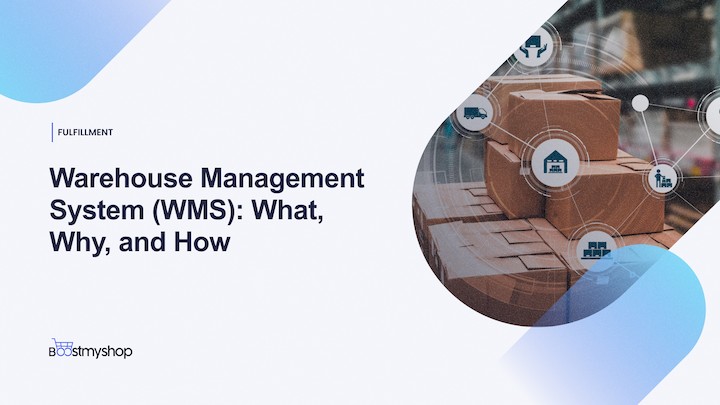Warehouse Management System (WMS): What, Why, and How
Warehouse Management refers to the control and seamless execution of everyday activities within a warehouse—like ordering inventory, tracking it, receiving it, relocating it, and using or selling them. Though it may sound straightforward, warehouse management involves complex operations that require careful attention. A Warehouse Management System (WMS) can be leveraged by businesses of all sizes to optimize their supply chain management and function efficiently with just the right resources.
The operations run on multiple levels, and a single mistake can become costly. Imagine a distribution center handling thousands of inventory items, calculating order quantities, organizing shelf spaces, checking due dates, ensuring correct delivery schedules, processing returned goods, and countless other tasks carried out daily. Such complexities can be handled with ease using proper warehouse management software.
What is a Warehouse Management System?
A Warehouse Management System, often abbreviated as WMS, is a software application that supports the day-to-day warehouse operations. It controls and tracks inventory, optimizes order preparation (particularly important for ecommerce), monitors stock levels, and improves customer satisfaction while reducing operating costs.
A modern WMS provides detailed visibility across all fundamental warehousing processes:
- Receiving
- Put-away
- Storage optimization
- Picking
- Packing
- Shipping
Because all warehouse data is typically stored in cloud-based systems, this information can be accessed from anywhere at any time—a huge advantage for businesses that need to monitor inventory levels and orders regularly. Cloud-based WMS solutions have become increasingly popular due to their flexibility and reduced IT infrastructure requirements.
Why do we need a Warehouse Management System?
A WMS is essential because it addresses the following challenges, which are prone to errors when managed manually:
1. Optimizing Warehouse Space
Real estate/warehouse space is a critical asset that should be utilized effectively. This means enhancing storage systems, as well as racking and pallet patterns. A robust WMS helps:
- Optimize warehouse layout
- Locate and provide empty locations for inventory
- Map the most efficient paths for goods movement
- Maximize vertical space utilization
- Reduce wasted space through intelligent slotting
2. Improving Inventory Control
One of the biggest benefits of implementing a WMS is enhanced inventory control accuracy. With a WMS in place, you can:
- Track inventory levels in real-time data
- Know exactly what’s in stock at any moment
- Reduce stock-outs and overstock situations
- Ensure the right products are available when needed
- Implement cycle counting for better accuracy
- Reduce inventory holding costs
3. Streamlining Order Fulfillment
Warehouse operations become more efficient with a WMS that:
- Schedules both inbound and outbound deliveries
- Maintains purchase and sales orders in one system
- Automatically schedules delivery dates in response to orders
- Optimizes picking routes to reduce travel time
- Enables batch picking for increased efficiency
- Provides real-time data on order status
4. Managing Demand Fluctuations
A sophisticated WMS helps businesses:
- Pre-order or back-order automatically based on customer demand
- Manage seasonal inventory effectively
- Forecast customer demand using historical data analysis
- Balance inventory levels across multiple locations
- Implement just-in-time inventory strategies
- Reduce operating costs through better planning
5. Processing Returns Efficiently
When products are returned due to customer dissatisfaction or damage, a WMS provides:
- Functionality to track returned orders
- Automated communication with vendors for refunds or replacements
- Quality control processes for returned items
- Options for restocking, repackaging, or disposal
- Analysis of return reasons to identify product issues
- Integration with customer service systems
How to Choose a Cost-Effective WMS
When selecting a Warehouse Management System, consider these key factors to ensure you find a cost-effective solution:
1. System Integration Capabilities
Ensure the WMS will integrate with your existing business systems:
- Look for pre-built integrations with popular ERP systems
- Check API capabilities for custom integrations
- Confirm compatibility with your inventory management software
- Verify integration with transportation management systems (TMS)
- An integrated Order Management System is an added advantage
2. User Experience and Interface
A good WMS should have:
- A modern, intuitive user interface
- Easy-to-learn functionality for warehouse staff
- Mobile compatibility for warehouse floor operations
- Barcode and QR code scanning capabilities
- Training resources and support materials
3. Scalability for Growth
As your business expands, your WMS should grow with you:
- Ensure the system can handle increased transaction volumes
- Check if additional modules can be added as needed
- Confirm multi-warehouse capability if expansion is planned
- Verify the system can accommodate new product lines
- Ask about performance under peak load conditions
4. Total Cost of Ownership
Understand all costs associated with the WMS:
- Initial implementation costs
- Monthly or annual subscription fees
- Training expenses
- Maintenance and support costs
- Hardware requirements (scanners, printers, etc.)
- Potential ROI through improved efficiency
Essential WMS Features to Consider
When evaluating warehouse management software, look for these critical features:
- Comprehensive Dashboard
- Customizable views for different user roles
- Real-time data visualization
- Performance metrics and KPIs
- Inventory status at a glance
- Order fulfillment progress tracking
- Advanced Scanning Capabilities
- Barcode and QR code scanning and printing
- RFID compatibility
- Mobile scanning apps
- Label generation and management
- Batch scanning for efficiency
- Robust Reporting
- Customizable report templates
- Scheduled automated reports
- Export capabilities in multiple formats
- Historical data analysis
- Compliance documentation
- Inventory Alerts
- Low stock notifications
- Reorder point automation
- Expiration date warnings
- Slow-moving inventory identification
- Stockout prevention systems
- Device Compatibility
- Mobile-friendly interfaces
- Support for iOS and Android devices
- Compatible with industrial handhelds
- Web browser accessibility
- Offline functionality with synchronization
The Future of Warehouse Management Systems
The future of warehouse management is evolving rapidly with technological advancements. As the ecommerce economy continues to grow, new innovations are transforming how we manage and store inventory:
Automation and Robotics
- Autonomous mobile robots (AMRs) for picking and transport
- Robotic process automation for repetitive tasks
- Automated storage and retrieval systems (AS/RS)
- Collaborative robots working alongside human staff
- Drone technology for inventory counting and surveillance
Advanced Technology Integration
- Artificial intelligence for demand forecasting
- Machine learning for continuous process improvement
- Internet of Things (IoT) for equipment monitoring
- Blockchain for supply chain transparency
- Augmented reality for picking guidance
Enhanced Mobility
- WMS integration with wearable wireless devices
- Voice-directed picking systems
- Smart glasses for hands-free operations
- Mobile workstations throughout the warehouse
- Real-time communication systems
Sustainable Operations
- Energy-efficient equipment and lighting
- Optimized routes to reduce carbon footprint
- Paperless processes throughout the warehouse
- Recyclable packaging materials
- Waste reduction strategies
By implementing a modern Warehouse Management System, businesses can significantly improve their supply chain management, reduce operating costs, and maintain a competitive edge in today’s fast-paced market.
WMS Warehouse System FAQs
How long does it typically take to implement a WMS warehouse system?
Implementation timeframes vary based on warehouse complexity and integration requirements. A basic implementation can be completed in 4-6 weeks, while more complex environments may require 3-6 months.
Can a WMS warehouse system integrate with our existing business systems?
Yes, modern WMS solutions like MyFulfillment offer robust APIs and pre-built integrations for ecommerce platforms, ERPs, shipping carriers, and other business systems.
What ROI can we expect from implementing a WMS?
Most businesses achieve full ROI within 12-18 months through labor savings, improved inventory accuracy, reduced carrying costs, and enhanced customer satisfaction.
How does a WMS handle seasonal volume fluctuations?
A robust WMS warehouse system helps manage seasonal peaks through labor forecasting, temporary staff onboarding tools, and workflow optimizations that maximize throughput during high-volume periods.



